Today (so far) I sewed the underarm seams.
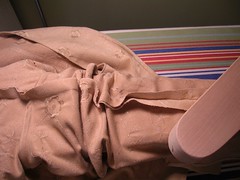
After sewing the seam normally, I turned the jacket inside-out and pressed the seam open.
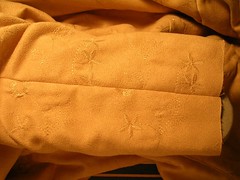
The annoying difference in colour is dependent on whether the flash goes off or not. This photo shows that even though I have pressed the seam open on the inside, it is not really flat on the outside. I press it again with the clapper and then again from the inside, to make the modified flat fell.
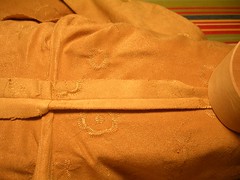
On the inside, I use my clapper to try to get a crease in the folded over seam allowance. This is tough for this fabric - it doesn't want to crease. Still, I don't want to use pins so I am creasing as much as humanly possible.
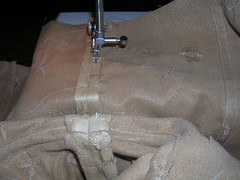
Once I've got both sides of the seam allowance pressed, I turn the jacket right side out again and start to sew the fell. I'm using my zipper foot and I am starting to sew down the right side, up from the bottom of the jacket. You can see I'm heading toward the armpit where the folds have already sprung open.
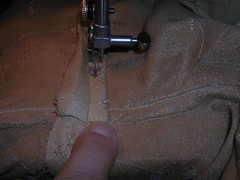
As I approach sections of the folded over seam allowance that have come unfolded, I stop - with the needle DOWN in the fabric so it doesn't move! - and fold the section back under and proceed, very slowly.
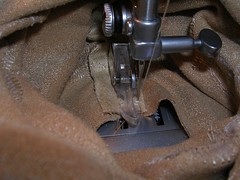
I continue sewing down the one side of the sleeve until I get to the end of the sleeve. This is the fun and tricky part, making sure you don't sew anything else that might get folded under the sleeve as you effectively sew down into the tube that the sleeve becomes. Here I am at the cuff end of the sleeve. All the wrinkled pile of fabric around the needle is the rest of the sleeve.
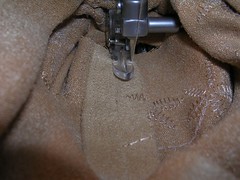
Now I have turned the sleeve around 180 degrees and am about to start sewing back out of it, down what was the left hand side of the seam.
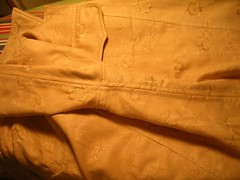
Here is what the entire underarm seam looks like when finished. Now do the second sleeve...
8 comments:
This looks great. I just got my Boho Patchwork Jacket from Hot Patterns and think I'll try this on it. It's got great opportunities for topstitching! Thanks for the step-by-step photos.
I'm having trouble with my sewing machine (well I always have trouble with it). I googled 'zigzag stitch skips' and one of the choices was about your 'pocket bag' and I was curious what that was so I clicked on the link. As soon as I saw your ironing board I realized that I had been here before. Probably from googling some other sewing search.
So I thought that I would tell you how much I like all of the pictures you show and that if I had a suitable machine to sew on, I'd probably use your tutorials.
Alisa and Stitchy, welcome to my blog! It's always nice to know I have new readers and that some of my musings might help. From your comments to publishers' ears!
Julia, whenever I go into my knittin store, I eye the husqvarna (sp?) sewing machines they have there. I don't sew...but if I were to start, could you recommend a machine that would be suitable for a beginner?
It depends on what kind of sewing you are doing. I don't do any fancy needlework and frankly, if I did, I would do it by hand (meaning embroidery). Therefore, I don't need any fancy stitches. You can pay a ton of money for a machine that does all kinds of fancy stuff but for the sewing of garments, all you really need is one that goes backwards and forward and has a zigzag -- and they all have that as a minimum. My first machine, and I used it for 20 years, was a Kenmore. They are made by the world's largest sewing machine company called Janome. Singer used to be "the" brand and that's what I am using now, but Singer has since been bought and sold and is no longer owned by the family. So I am not sure if I would recommend one brand over another. I think if you get one with a 5 year warranty, you should be doing well. The first year is when things usually go wrong anyway. You want a machine that is solid and well built and I think most of the mainstream brands fit that criterion. You don't want a toy machine - anything under $200 or so would be a toy. But you don't need to spend much more than that to get something that you can be happy with for 20 years.
Thanks Julia!
Sharon, thanks for the compliment! You can do practically anything with enough patience, I suppose.
Hi, just found your blog! You rock, your sewing skills are awesome... I'm off to my sewing class. Can't wait to keep on reading all the stuff you've so graciously posted.
thank rob
sewablesbyrobbie.com
Post a Comment